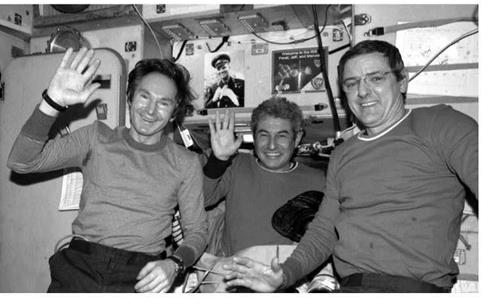. SOYUZ TMA8
Flight Crew
VINOGRADOV, Pavel Vladimirovich, 52, civilian, Russian ISS-13 and Soyuz
commander, 2nd mission
Previous mission: Soyuz TM26 (1997)
WILLIAMS, Jeffery Nels, 48, US Army, ISS-13 science officer, 2nd mission Previous mission: STS-101 (2000)
PONTES, Marcos Caesar, 43, Brazilian Air Force, space flight participant
Flight Log
The appointment of the Brazilian astronaut to the crew came from a commercial agreement between the Brazilian space agency and the Russian space agency. The programme of scientific experiments under the Centenario label included eight small experiments being operated by Pontes in the Russian segment; one biomedical experiment, three biotechnology experiments, two engineering research experiments, and two educational experiments. The Brazilian also participated in a number of ceremonial and media activities as the first Brazilian in space. He returned to Earth on 9 April with the ISS-12 crew aboard TMA7.
The docking with ISS had occurred on 1 April. The hand over activities between the two main crews took a week before the ISS-12 crew and Pontes returned to Earth, leaving the new crew to continue the long ISS programme. As well as science work, ISS-13 conducted routine and unplanned maintenance, and exercised to maintain their condition during their six-month tour of duty. Earth resources and photography had long been an important programme from manned spacecraft and this flight was no exception. The crew photographed and observed the eruption of the Cleveland volcano on the Aleutian Islands in Alaska.
Their first EVA occurred on 2 June (6 hours 31 minutes) and included tasks on both the US and Russian segments. The EVA began from Pirs with the crew wearing
|
The first Brazilian astronaut, Marcos Pontes (centre), works aboard ISS during April 2006 |
Russian Orlan M suits. They installed a new valve nozzle on the side of Zvezda that would be used as a hydrogen exhaust from the Elektron oxygen generator. They also photographed the antenna to be used for ATV docking for analysis on Earth, to ensure they are correctly aligned when ATV operations begin. The crew also retrieved several exposure experiments and cassettes and removed a failed camera, replacing it with a new one on the MT.
In July, STS-121 visited ISS in the second of two return-to-flight missions. This time, the Shuttle delivered 3,356 kg of supplies to the station, as well as German ESA astronaut Thomas Reiter. He transferred to the main crew to work with ISS-13, returning the ISS crew to a complement of three for the first time since May 2003. Reiter would conduct the ESA Astrolab science programme while aboard the station. With the successful flight of STS-121, the expansion of the station would soon be resuming as the ISS-13 residence wound down. Reiter would continue with the ISS-14 crew for a few more weeks. On 3 August, Williams and Reiter completed an EVA (5 hours 54 minutes) that included the installation of hardware in preparation for future ISS assembly work, as well as deploying a number of instruments and experiments on the outside of the station.
In September 2006, the ISS-13 crew hosted the STS-115 crew for the first Shuttle assembly mission since STS-113 in November 2002. While docked to the station, the STS-115 crew added a further solar array truss and transferred logistics to support station operations.
On 19 September, the day after the STS-115 crew departed and the same day the Soyuz TMA9 crew were launched, the ISS-13 crew, after servicing the Elektron device in the service module, noted a small leak of KOH (potassium hydroxide, “caustic potash”) electrolyte bubbles from the O2 outlet nozzle. The crew immediately manually activated the fire alarm, which automatically shut down the ventilation system. Following the mission rules after such incidents, and as an extra precaution, all three men donned goggles, gloves, and surgical masks. The released caustic liquid (which was deemed to be Level 2 Toxicity – an “irritant”) was immediately cleaned up with a cloth and no further leaks were noted. About 30 minutes later, the Vodzukh was activated, with a charcoal filter installed to scrub the air. Recorded air data remained well within acceptable values and protective gear was soon no longer required as onboard operations returned to the nominal schedule. At the time of the situation, ground controllers instigated a “spacecraft emergency” procedure to ensure that TDRS communication coverage would be at the highest priority. In the event this was not required and TDRS coverage was returned to normal.
The ISS-13 crew handed over to the ISS-14 crew the following week, completing several days of joint activities with them and space flight participant Anousheh Ansari. The ISS-13 crew landed in TMA8 with Ansari in the early hours of 29 September.
Milestones
247th manned space flight
101st Russian manned space flight
94th manned Soyuz mission
8th manned Soyuz TMA mission
41st Russian and 96th flight with EVA operations
10th ISS Soyuz mission (10S)
13th ISS resident crew (EO-13)
10th visiting mission (VC-10)
5th resident caretaker ISS crew (2 person – until July) 1st Brazilian citizen in space











